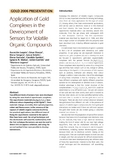Mostrar el registro sencillo del ítem
Application of gold complexes in the development of sensors for volatile organic compounds
| dc.creator | Luquin, Asunción | es_ES |
| dc.creator | Elosúa Aguado, César | es_ES |
| dc.creator | Vergara, Elena | es_ES |
| dc.creator | Estella, Juncal | es_ES |
| dc.creator | Cerrada, Elena | es_ES |
| dc.creator | Bariáin Aisa, Cándido | es_ES |
| dc.creator | Matías Maestro, Ignacio | es_ES |
| dc.creator | Garrido Segovia, Julián José | es_ES |
| dc.creator | Laguna, Mariano | es_ES |
| dc.date.accessioned | 2014-06-04T11:15:20Z | |
| dc.date.available | 2014-06-04T11:15:20Z | |
| dc.date.issued | 2007 | |
| dc.identifier.issn | 0017-1557 (print) | |
| dc.identifier.issn | 2190-7579 (electronic) | |
| dc.identifier.other | 809 | |
| dc.identifier.uri | https://hdl.handle.net/2454/10730 | |
| dc.description.abstract | Two different kinds of sensors have been developed by using the same kind of vapochromic complexes. The vapochromic materials [Au2Ag2(C6F5)(4)L-2](n) have different colours depending on the ligand L. These materials change, reversibly, their optical properties, colour and fluorescence, in the presence of the vapours of volatile organic compounds (VOCs). For practical applications, two different ways of fixing the vapochromic material to the optical fibre have been used: the sol-gel technique and the electrostatic self-assembly method (ESA). With the first technique the sensors can even be used to detect VOCs in aqueous solutions, and using the second method it has been possible to develop nanosensors. | en |
| dc.description.sponsorship | The authors thank the Ministerio de Ciencia y Tecnología Spain for financial support (CTQ2005-08099-C03-01 and CTQ2005-08099-C03-02) | en |
| dc.format.mimetype | application/pdf | en |
| dc.language.iso | eng | en |
| dc.publisher | World Gold Council | en |
| dc.relation.ispartof | Gold Bulletin, 2007, 40(3). Págs. 225-233 | en |
| dc.rights | Attribution 4.0 International (CC BY 4.0) | es_ES |
| dc.rights.uri | http://creativecommons.org/licenses/by/4.0/ | |
| dc.subject | Metal metal bonds | en |
| dc.subject | Optical fiber | en |
| dc.subject | Environmental sensors | en |
| dc.subject | Vapochromic | en |
| dc.subject | Behavior | en |
| dc.subject | Crystal structures | en |
| dc.subject | Humidity sensors | en |
| dc.subject | Gases | en |
| dc.subject | Diffraction | en |
| dc.subject | Vapors | en |
| dc.subject | Salts | en |
| dc.title | Application of gold complexes in the development of sensors for volatile organic compounds | en |
| dc.type | Artículo / Artikulua | es |
| dc.type | info:eu-repo/semantics/article | en |
| dc.contributor.department | Química Aplicada | es_ES |
| dc.contributor.department | Kimika Aplikatua | eu |
| dc.contributor.department | Ingeniería Eléctrica y Electrónica | es_ES |
| dc.contributor.department | Ingeniaritza Elektrikoa eta Elektronikoa | eu |
| dc.rights.accessRights | Acceso abierto / Sarbide irekia | es |
| dc.rights.accessRights | info:eu-repo/semantics/openAccess | en |
| dc.identifier.doi | 10.1007/BF03215585 | |
| dc.relation.publisherversion | https://dx.doi.org/10.1007/BF03215585 | |
| dc.type.version | Versión publicada / Argitaratu den bertsioa | es |
| dc.type.version | info:eu-repo/semantics/publishedVersion | en |



